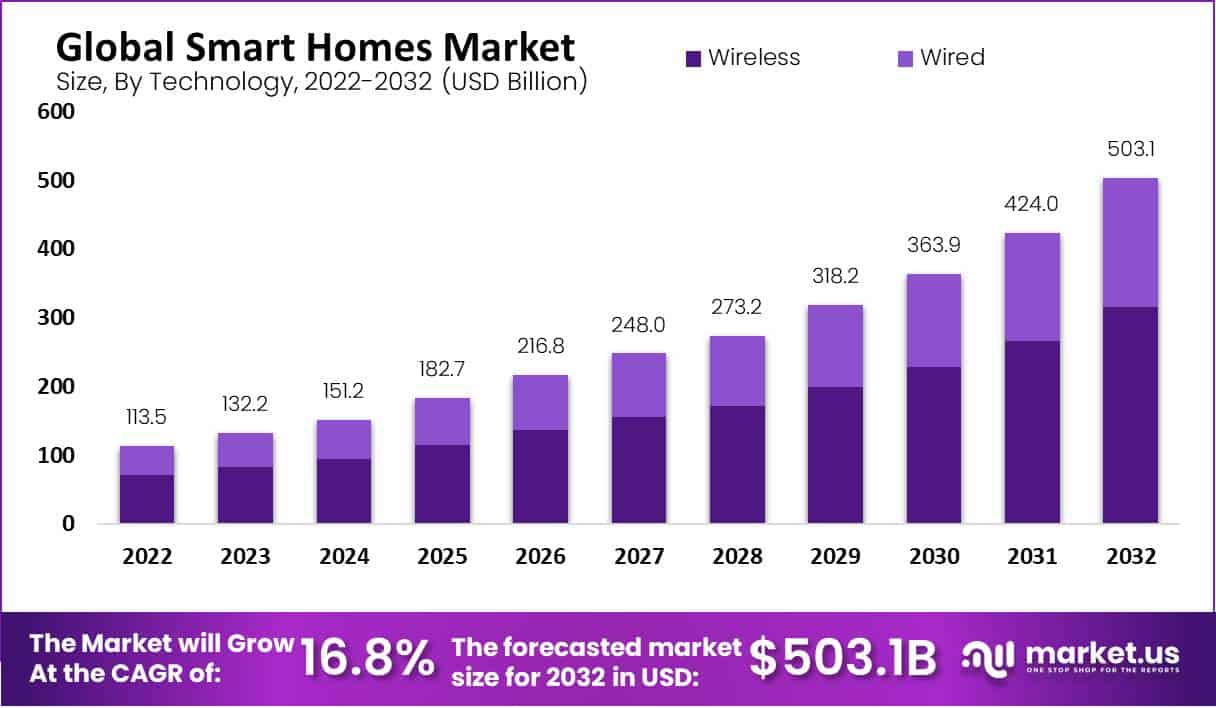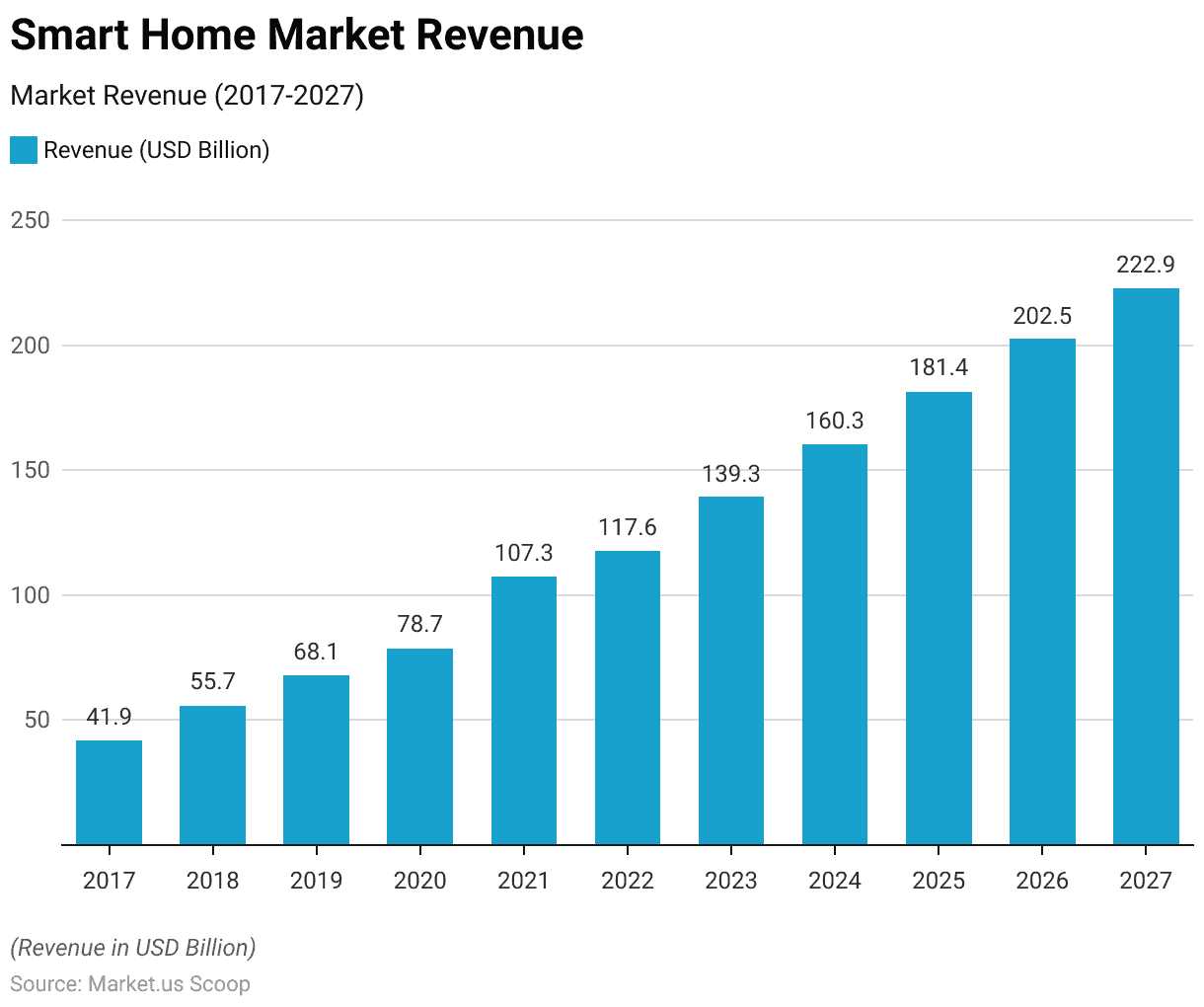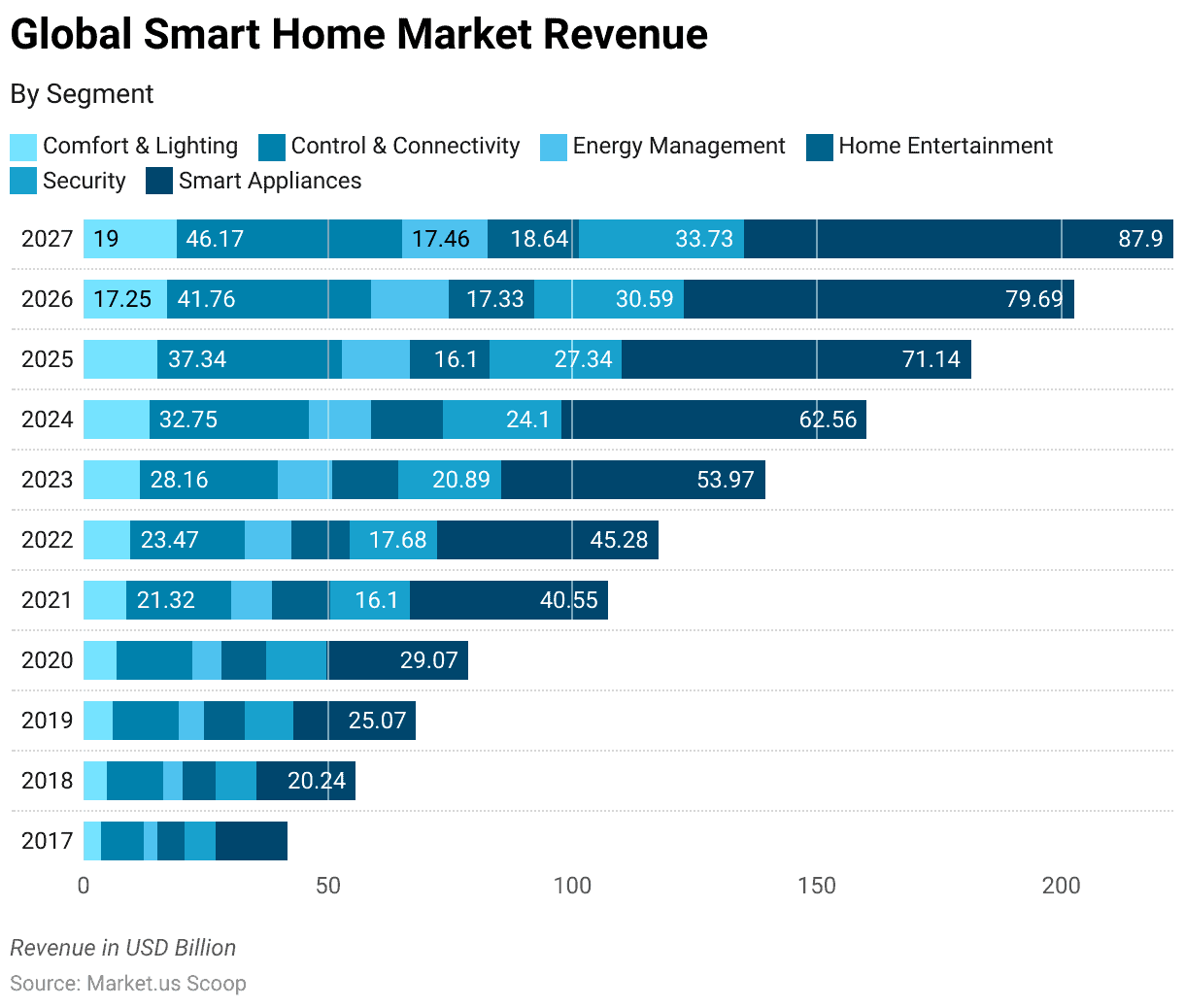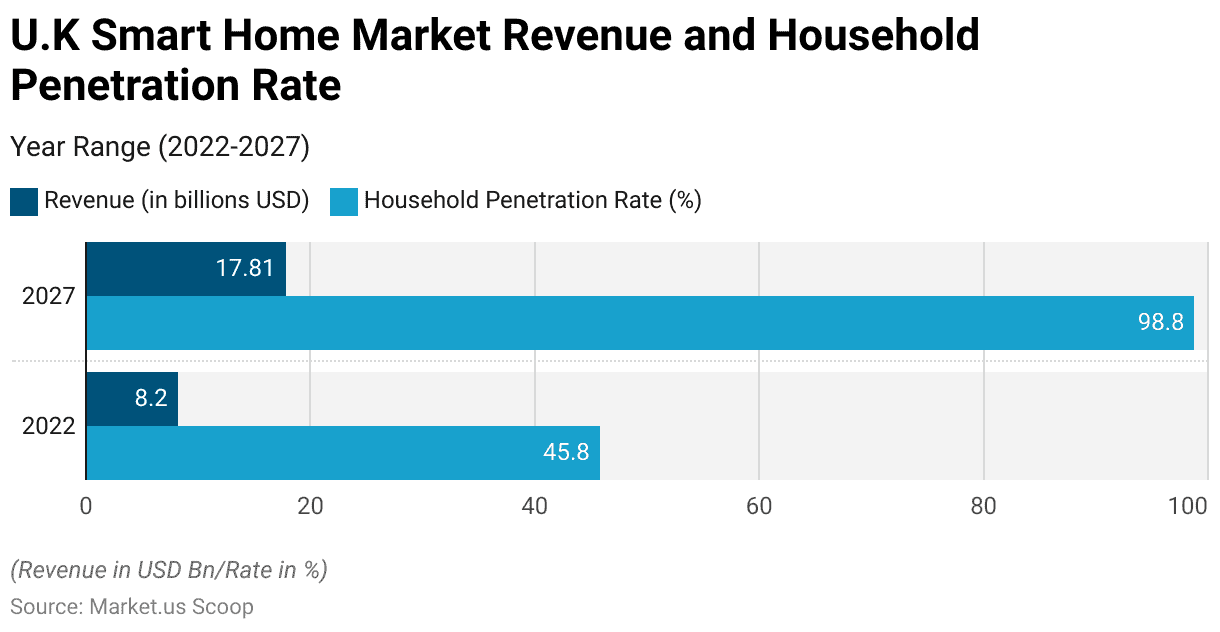Table of Contents
- Introduction
- Editor’s Choice
- Global Smart Home Market Size
- Smart Home Statistics – Market Size by Segment
- Smart Home Statistics – Regional Market Analysis
- Smart Home Statistics – Key Players in the Industry
- Smart Home Statistics – Devices and Technologies
- Smart Home Statistics According to Demographics
- Recent Developments
- Conclusion
- FAQ
Introduction
Smart Home Statistics: A smart home refers to a residence equipped with various devices, appliances, and systems that are interconnected and can be remotely controlled and automated.
These connected devices are often integrated into a centralized smart home ecosystem. Allowing homeowners to manage and monitor their home’s functions through a smartphone, tablet, or voice-controlled assistant.
The concept of a smart home is continually evolving as new technologies and devices are developed. With ongoing innovations, smart homes are becoming an integral part of modern living, offering increased comfort, security, and efficiency.
The concept of a smart home is continually evolving as new technologies and devices are developed. With ongoing innovations, smart homes are becoming an integral part of modern living, offering increased comfort, security, and efficiency.

Editor’s Choice
- The Smart Home market revenue was projected to reach US$117.60 billion in 2022. It is expected to continue growing at an annual rate of 12.47%, resulting in a projected market volume of US$222.90 billion by 2027.
- The number of active households using Smart Home technology is expected to reach 672.60 million by 2027. Household penetration is expected to increase from 14.2% in 2022 to 28.8% in 2027.
- The current average revenue per installed Smart Home is estimated to be around US$381.90.
- The United States is a significant revenue generator, with the most revenue generated in 2022, reaching US$31,450.00 million.
- Smart speakers are widely adopted, with 79% of households having them installed. Other popular devices include smart lighting systems, security cameras, and smart TVs.
- Millennials show the highest interest in Smart Home technology. With 47% of them having installed at least one smart device in their homes.
- Gen Xers follow with 33% ownership of smart home devices. While individuals aged 55 and older show lower interest, with only 24% owning such devices.

Global Smart Home Market Size
- The Smart Home industry is poised for remarkable growth, with an estimated revenue of US$117.60 billion anticipated for 2022.
- This expansion is projected to continue at an impressive annual rate of 12.47% from 2022 to 2027, leading to a substantial market volume of US$222.90 billion by 2027.
- The number of active households embracing Smart Home technology is expected to reach 672.60 million by 2027. Reflecting a significant increase in household penetration from 14.2% in 2022 to 28.8% in 2027.
- Presently, the average revenue per installed Smart Home is around US$381.90.
- Notably, the United States stands out as the largest revenue contributor. Projected to reach an impressive revenue of US$31,450.00 million in 2022. This growth can be attributed to the growing popularity of smart devices, automation, and the escalating demand for convenience, energy efficiency, and enhanced security in contemporary households.
(Source: Statista)

Smart Home Statistics – Market Size by Segment
- The Smart Home market has shown significant growth across various segments over the years. In the Comfort & Lighting segment, revenue increased steadily from $3.68 billion in 2017 to $19 billion projected for 2027.
- Control & Connectivity experienced robust growth, rising from $8.58 billion in 2017 to an estimated $46.17 billion by 2027. Similarly, the Energy Management segment saw steady expansion. Reaching $17.46 billion in projected revenue for 2027 from $2.95 billion in 2017.
- Home Entertainment witnessed consistent growth, climbing from $5.55 billion in 2017 to projected revenue of $18.64 billion by 2027.
- The Security segment demonstrated remarkable expansion, soaring from $6.26 billion in 2017 to an anticipated $33.73 billion by 2027.
- Smart Appliances exhibited exceptional growth, rising from $14.86 billion in 2017 to an estimated $87.90 billion in revenue by 2027. These figures indicate the increasing adoption of smart technologies across various aspects of modern households. The market’s impressive growth is driven by the rising demand for comfort, convenience, energy efficiency, and enhanced security, propelling the Smart Home industry into a promising and dynamic future.
(Source: Statista)

Smart Home Statistics – Regional Market Analysis
United States Smart Home Market
- Projected revenue for the Smart Home market is set to reach US$31.45 billion in 2022, with an anticipated CAGR of 10.22% during 2022-2027. Leading to an estimated market volume of US$52.19 billion by 2027.
- The number of active households using Smart Home technology is expected to reach 93.59 million by 2027. Representing a household penetration rate of 68.6% compared to 43.8% in 2022.
- Currently, in the U.S., on average, the revenue per installed Smart Home is estimated to be US$546.50.
- Among global regions, the United States leads with the highest revenue, projected to be US$31.45 billion in 2022. These figures illustrate the substantial growth and increasing adoption of Smart Home technologies worldwide. Driven by the demand for advanced home automation, energy efficiency, and enhanced convenience.
(Source: Statista)
Take advantage of our unbeatable offer - buy now!


China Smart Home Market
- The China Smart Home market is predicted to achieve revenue of US$26.67 billion in 2022. With a projected annual growth rate (CAGR 2022-2027) of 14.36%. Leading to an estimated market volume of US$54.63 billion by 2027.
- By 2027, the number of active households using Smart Home technology in China is expected to reach 164.90 million. Indicating a household penetration rate of 34.0%, compared to 16.6% in 2022.
- The average revenue per installed Smart Home currently stands at approximately US$340.10. Notably, the United States generates the most revenue globally, with an expected revenue of US$31,450.00 million in 2022. These figures highlight the remarkable growth and increasing adoption of Smart Home technologies. Driven by the demand for enhanced home automation, energy efficiency, and convenience worldwide.
(Source: Statista)
United Kingdom Smart Home Market
- The U.K. Smart Home market is anticipated to reach a revenue of US$8.20 billion in 2022. With a projected annual growth rate (CAGR 2022-2027) of 14.45%, resulting in a market volume of US$17.81 billion by 2027.
- The number of active households using Smart Home technology in the U.K. is expected to reach 29.70 million by 2027. Representing a household penetration rate of 98.8% compared to 45.8% in 2022.
(Source: Statista)

Smart Home Statistics – Key Players in the Industry
- In 2022, the Smart Home market was highly competitive, with several brands vying for market share. Notably, Google, Irobot, and TP-Link each held a 5% share of the market. Highlighting the strong presence of these companies in the industry.
- Amazon, Samsung, and Xiaomi closely followed, with each securing a 4% share. Other significant players included Robot, Danalock, LG, and Ring, each holding a 3%, 2%, 2%, and 2% share, respectively. This even distribution of market share among various prominent brands indicates a dynamic and diverse landscape in the Smart Home sector. With each brand striving to offer innovative and appealing solutions to capture the attention of consumers.
(Source: Statista)

Smart Home Statistics – Devices and Technologies
- As of 2022, voice-controlled devices are installed in 50% of U.S. households, while 41% have smart appliances, and 36% have smart lighting systems. Smart speakers have gained substantial traction, with a remarkable 79% of households having them installed.
- Looking towards 2025, the global smart device market will be dominated by smart lighting systems (26%), security cameras (23%), smart speakers (19%), smart TVs (14%), and other smart devices (18%).
- Within the United States, smart TVs are the most prevalent smart home device, with 57% of households using them.
- Furthermore, smart devices have made their way into kitchens, where 29% of households utilize them for cooking and other tasks, while refrigerators, dishwashers, and dryers contribute to 28% of smart kitchen adoption.
- In terms of health and fitness, 2% of Americans incorporate smart home gyms, smart exercise bikes, and smart treadmills.
- Security-wise, 4.8% own interactive security hubs, 4.6% have smart air quality monitors and various smart sensors like window sensors (7.2%) and smart smoke detectors (7.6%) are gaining popularity. Additionally, 8.2% of Americans have embraced smart door locks, while 1.6% have installed smart padlocks and smart mailboxes.
- Outdoor applications have also seen some adoption, with 3.4% of Americans using smart sprinkler control systems and 2.6% employing outdoor lighting systems. These statistics illustrate the extensive integration of smart devices into various aspects of American households, with smart TVs emerging as the most favored device.
(Source: Enterprise Apps Today)
Smart Home Statistics According to Demographics
- In the United States, a significant proportion of individuals aged 55 years and above, comprising 57%, exhibit no interest in integrating smart gadgets into their residences.
- On the other hand, men demonstrate greater proactivity than women when it comes to adopting smart home devices.
- Approximately 17% of men and 13% of women utilize these devices to achieve reduced utility bills.
- For both men and women belonging to the age group of 35 to 54 years, 36% regard security cameras as their primary choice for home protection. Conversely, women show a preference for security devices that enhance the overall efficiency of their smart homes.
- Among women aged between 25 to 34 years, 14% prefer automatic locks as a security measure for their homes. On the millennial front, 47% in the United States have already embraced at least one smart device in their households.
- When analyzing different age groups, we find that 21% of households with consumers aged between 18 to 49 years own smart speakers. The appeal of smart home devices is evident among 82% of men and 49% of women in the United States, with a majority having integrated at least one smart device into their homes.
- In terms of generational ownership, we observe that 90% of Gen X, 39% of Baby Boomers, and 33% of the Silent Generation in the United States have already adopted at least one smart device.
- From a demographic perspective, it appears that Millennials are the most inclined to adopt such technology, with 44% of them owning at least one smart home device.
- Gen Xers follow with 33% owning smart home devices, while only 24% of individuals aged 55 and older show interest in such devices, or in the U.S. smart home market in general.
(Source: Enterprise Apps Today, MarketingCharts)
Recent Developments
Acquisition:
- Google’s Acquisition of Fitbit: Google acquired Fitbit for $2.1 billion. This acquisition aims to integrate Fitbit’s health and fitness tracking capabilities with Google’s existing smart home ecosystem, enhancing user experience and data integration.
New Product Launches:
- Amazon’s Echo Show 10: Amazon launched the Echo Show 10, featuring a 10.1-inch HD display that follows users as they move. This device offers improved audio quality and compatibility with other smart home devices, enhancing home automation and user convenience.
- Schneider Electric’s Integration of Matter Standard: Schneider Electric announced the integration of the Matter standard across its connected home and buildings portfolio, enhancing interoperability among smart devices.
Funding:
- Wyze’s Series C Funding Round: Wyze, known for affordable smart home products, raised $110 million in a Series C funding round. This funding will support the development of new smart home devices and expansion efforts.
Innovation in Smart Home Technologies:
- Advancements in Voice Assistants: Companies like Amazon, Google, and Apple are continuously enhancing their voice assistant technologies to provide more intuitive and personalized smart home experiences.
- These improvements include better natural language processing, multi-language support, and broader integration with smart home devices.
Strategic Partnerships:
- Samsung and Oracle Collaboration: Samsung partnered with Oracle to develop smart energy solutions.
- This partnership aims to combine Oracle’s energy insights with Samsung’s SmartThings products, providing enhanced features for energy management and home automation.
Conclusion
Smart Home Statistics – Smart home devices have become an integral part of modern homes. Offering various benefits such as convenience, energy efficiency, and enhanced security.
Smart speakers, smart lighting systems, security cameras, and smart TVs are among the most widely adopted devices.
The market revenue has been projected to reach impressive figures, with a strong CAGR expected over the next few years.
The increasing number of active households using Smart Home technology indicates the growing popularity of these devices.
Demographically, Millennials are leading the way in embracing Smart Home technology, with Gen Xers also showing considerable interest. However, there is still a lower level of interest among individuals aged 55 and older.
Overall, the smart home industry is poised for a promising future, as more people recognize the advantages and convenience offered by these advanced technologies in making homes smarter and more efficient.
FAQ
The projected revenue for the Smart Home market in 2022 is US$117.60 billion.
The household penetration rate is expected to be 14.2% in 2022 and increase to 28.8% by 2027.
The United States generates the most revenue, with US$31,450.00 million projected for 2022.
Smart speakers are widely adopted, with 79% of households having them installed. Other popular devices include smart lighting systems, security cameras, and smart TVs.
Millennials show the highest interest in Smart Home technology, with 47% of them having installed at least one smart device in their homes.
Gen Xers have the highest ownership of Smart Home devices, with 90% of them owning at least one smart device.
Discuss your needs with our analyst
Please share your requirements with more details so our analyst can check if they can solve your problem(s)



